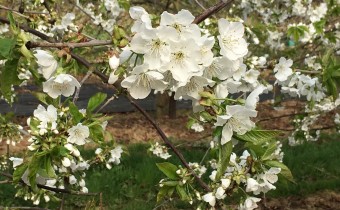

The cherry is back on top of the cake after the industry suffered a rare jolt last year following a poor harvest in 2016. And with major investment from leading players, a new year-round marketing campaign and double-digit sales growth, growers are once again focusing on taking the category to the next level.
Figures from Kantar Worldpanel show that UK value sales rose a healthy 20.2 per cent to £131.4 million in the year to 25 February 2018, an increase that added over £22m to the category. Volume sales also rose by 14.7 per cent, while all other key metrics – penetration, frequency, spend – also went up.
There is further good news, as Kantar consumer insight director Ed Griffiths points out, with the fact that frozen cherry sales are up 38 per cent to £7m and ambient sales, in the form of canned fruit, are starting to make an impression on the market too with £1m of sales.
It all points to a product going places, and the industry is looking to capitalise by following the blueprint that has been credited with helping drive the berry category to sales of over £1.2 billion. The Seasonal Cherries campaign, chaired by Norton Folgate managing director Matt Hancock and administered by PR agency The Red Brick Road, has moved away from a purely British promotion and has brought the import season into the fold, with the aim of keeping cherries in the consumer’s eye year-round. With all key British growers, plus importers, now contributing to the fund, it has more financial clout to promote the benefits and taste credentials of cherries to the public. While details of this year’s campaign are still under wraps, there will be a strong social media push on Instagram and a range of other themed activities, and the initiative is set to benefit everyone rather than being retailer-specific.
Hancock says the ultimate aim is to replicate the kind of success seen by individual berries, where lines such as blueberries have posted phenomenal growth from a relatively low base. “If you look at frequency of purchase and penetration, cherries is still a long way behind berries,” he points out. “There’s plenty of headroom for growth, and we should be aspiring to the type of growth berries are getting.”
If that’s the goal, then there are still some issues to be resolved, particularly around creating a genuinely year-round offer. The shoulders of the season lack significant availability of fruit, and prices are often prohibitive. It’s something that breeders and growers are looking at, and it may be that true 12-month supply is required before the sector can really jump into the stratosphere.
As for this season, British growers are upbeat about what’s ahead. “We are looking forward to a long and successful 2018 British cherry season,” says Mike Gibbon, sales director at Berry Gardens. “With the long cold winter, the orchards have had more than enough chill hours, and from our recent orchard walks we have not seen any significant damage from the very recent cold snap. The good chill hours combined with the benefit of having the most production under cover and the wide range of varieties we have available means we expect the 2018 season to be high quality and consistent taste and size.”

With new orchards coming into full production and plantings increasing, there’s every reason to believe double-digit sales growth can be sustained, and growers are investing too. Gibbon reports, for example, that Berry Gardens growers have been trialling new varieties as well as installing state-of-the-art optical grading machinery and chilling technology to maintain fruit quality.
Leading British grower Mansfields has been spending big, with owner Paul Mansfield revealing that the company has invested some £2m in the past two seasons to take its production capability to the next level. That includes having an optical grader put in at a cost of £1.5m (backed by a 40 per cent grant) and featuring a three-tier cutting system for stalks. Describing the installation as “the most gentle machine we’ve come across”, Mansfield says the machine brings a new standard in product quality, and adds to a range of investment in kit that includes a new hydrocooler that can handle 50-60 tonnes of cherries a day as part of a process that gets product from farm to store in under three hours. The company has also got two bespoke sprayers for tunnel use, which Mansfield says are unique in the UK, to support its 225 acres of covered cherries.
Hancock, who describes the mood at a meeting of international cherry growers last week as “buoyant”, predicted a strong Spanish crop coming through, but supplies are expected to be seven to 10 days late thanks to the recent weather. The season kicks off with a small amount of Spanish glasshouse crop before moving into Californian supply, the first British crop in June and then the main domestic season.
With supplies shaping up nicely and investments coming to fruition, there’s no reason why those strong sales figures can’t continue their impressive upward momentum.
Analysis: Stage set for growth
Cherries are poised to take a bigger share of retail sales in Britain and bring new business to growers here as a result, writes Fruitnet Media International MD Chris White. That’s the key message that I took home with me from Norton Folgate’s supplier conference last week, which I attended as an observer who wanted to understand better the future shape of the global cherry business.
Ours is already an important market with more potential for cherry suppliers from Europe and the rest of the world, all the more so given the relatively low penetration that cherries have achieved here so far. Our growing appetite for cherries underpins new plantings and production in Kent, Suffolk, and Hampshire as well as in central Scotland.
British Cherry Growers’ £2m investment in the country’s largest bespoke cherry grading facility seems a very shrewd move, especially as cherries get ranged alongside berries on the high street and benefit from their halo effect. The big challenge now is to build sales outside our peak season, especially in the dog days of winter when the cherry business hits the doldrums here. It’s not going to be straightforward; indeed it begs the question of quite how we’re going to be able to get Chile to pay us more attention at a time when the southern hemisphere’s biggest cherry supplier is transfixed by China, which buys more than 80 per cent of its total crop at high prices in advance of Chinese New Year.
Growers in South Africa and Australia won’t complain too loudly, as they stand to benefit most, with Spain and the US also growing earlier and later fruit to fill the supply gaps they don’t cover already. Bigger pack sizes at eye-catching price points will make them a regular on shopping lists both on and offline, while a keener focus on varieties that eat as well as they look augurs well for the future of the cherry business. And that’s surely good news for all of us who hunger for more value in the business today. After all, many more of us stand to benefit if there’s a cherry on every cake.






No comments yet